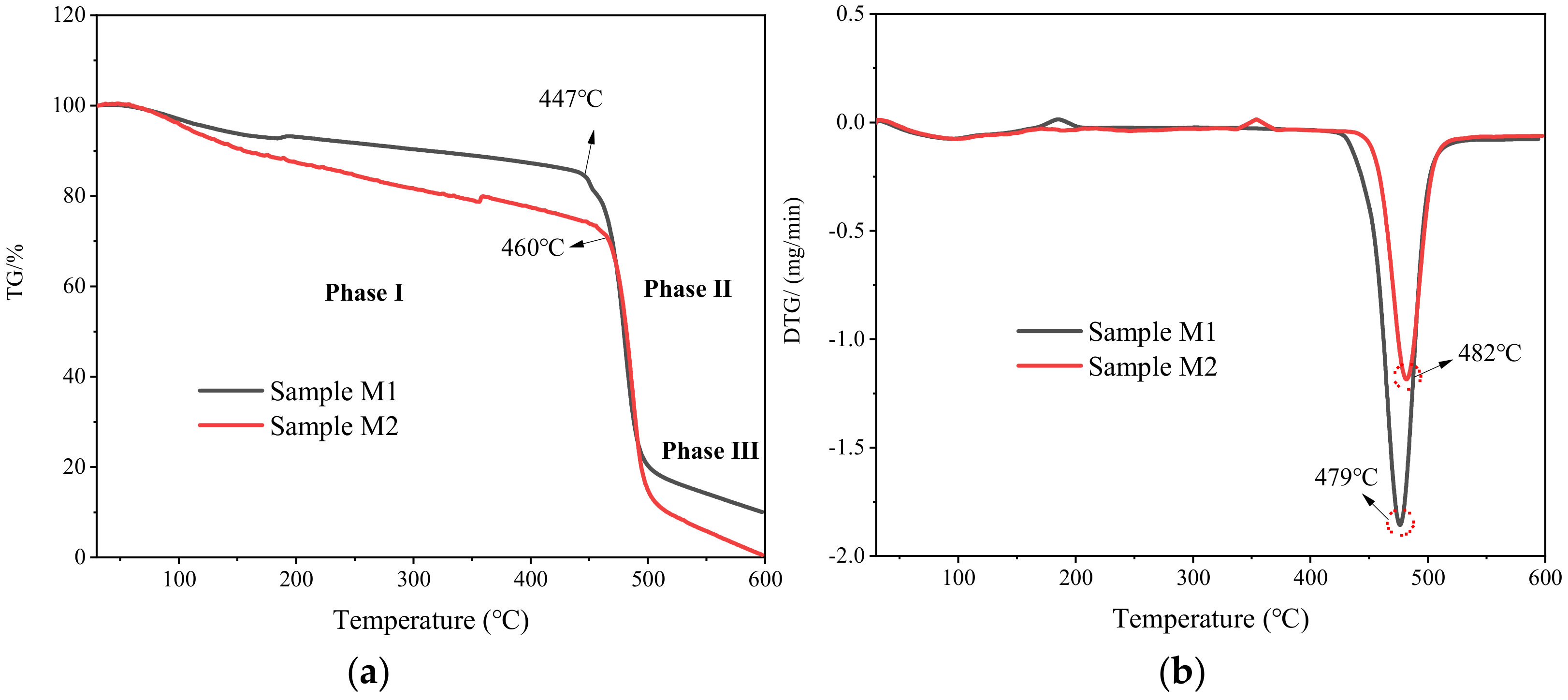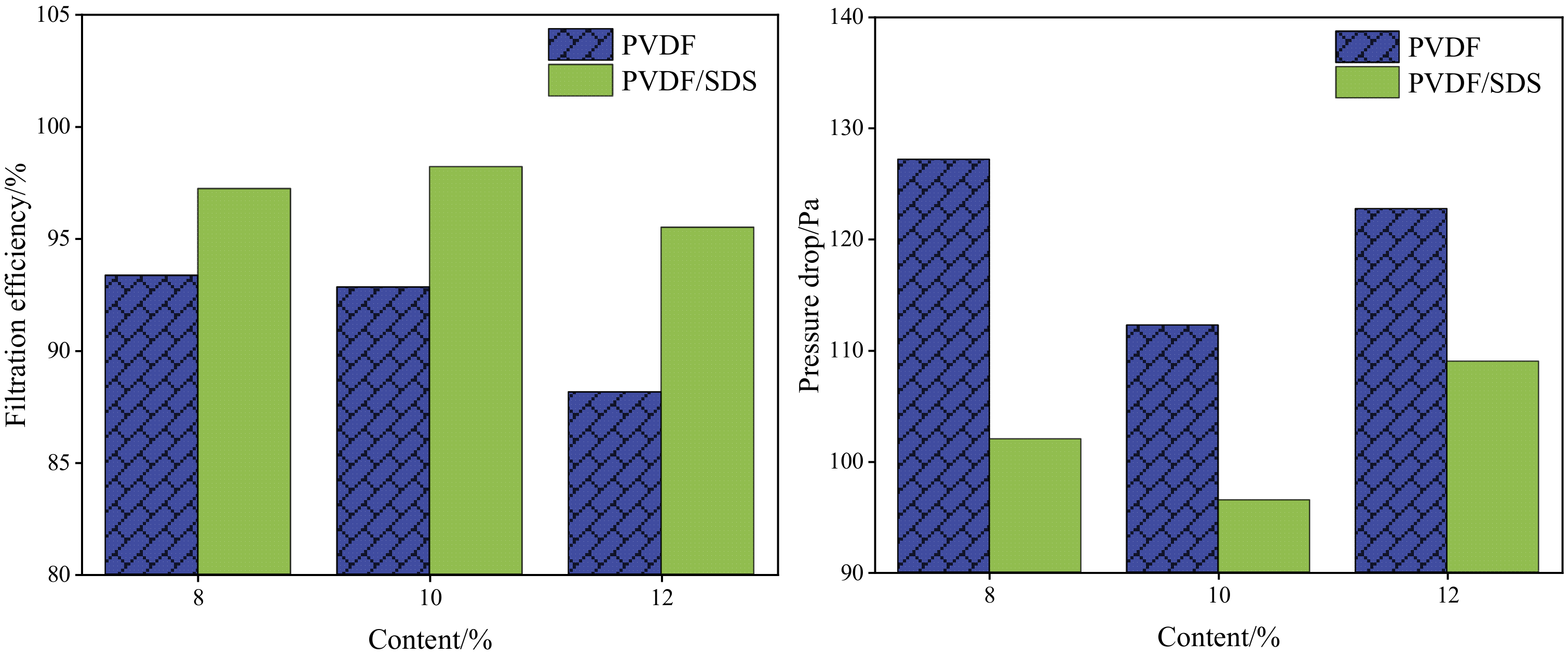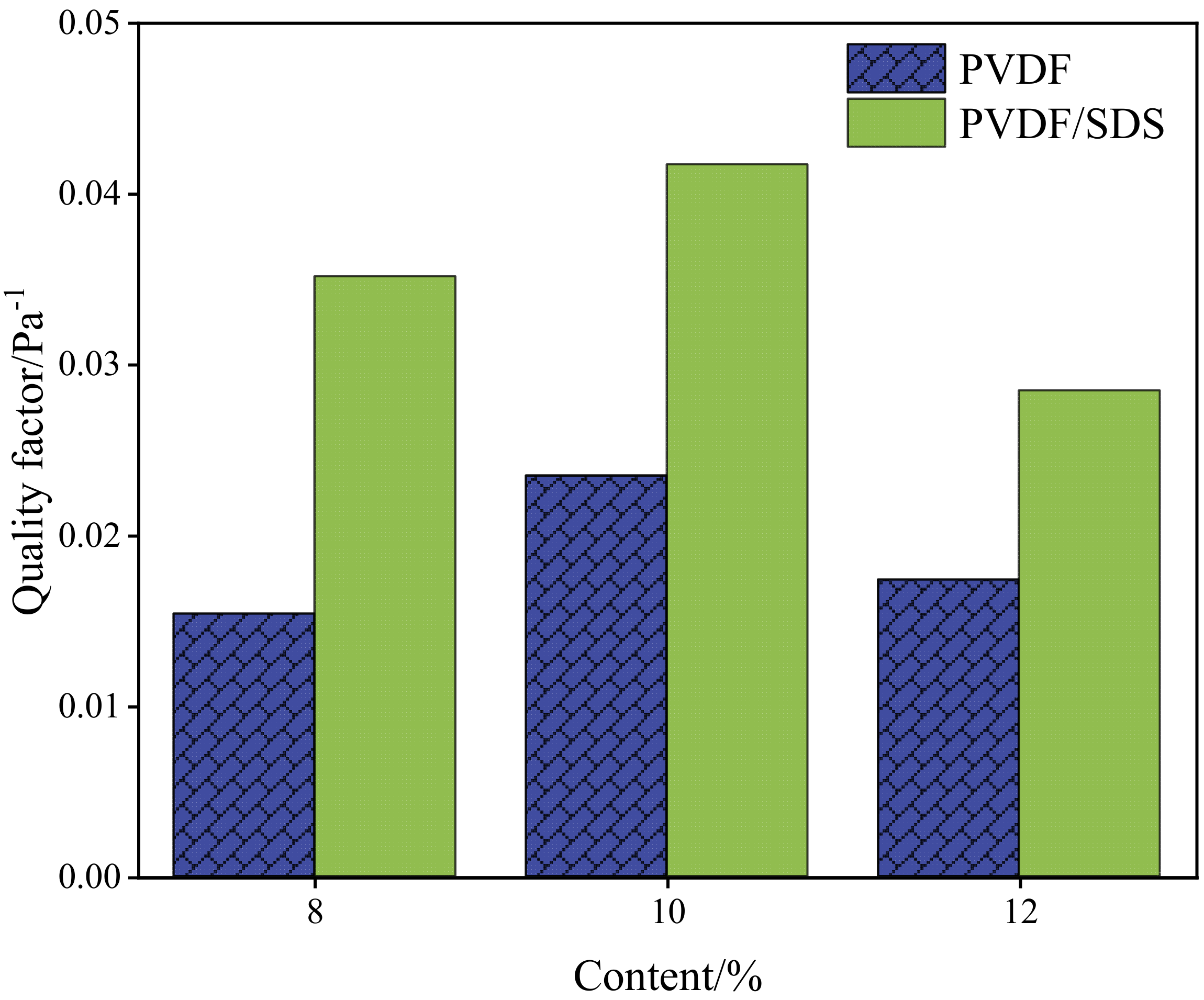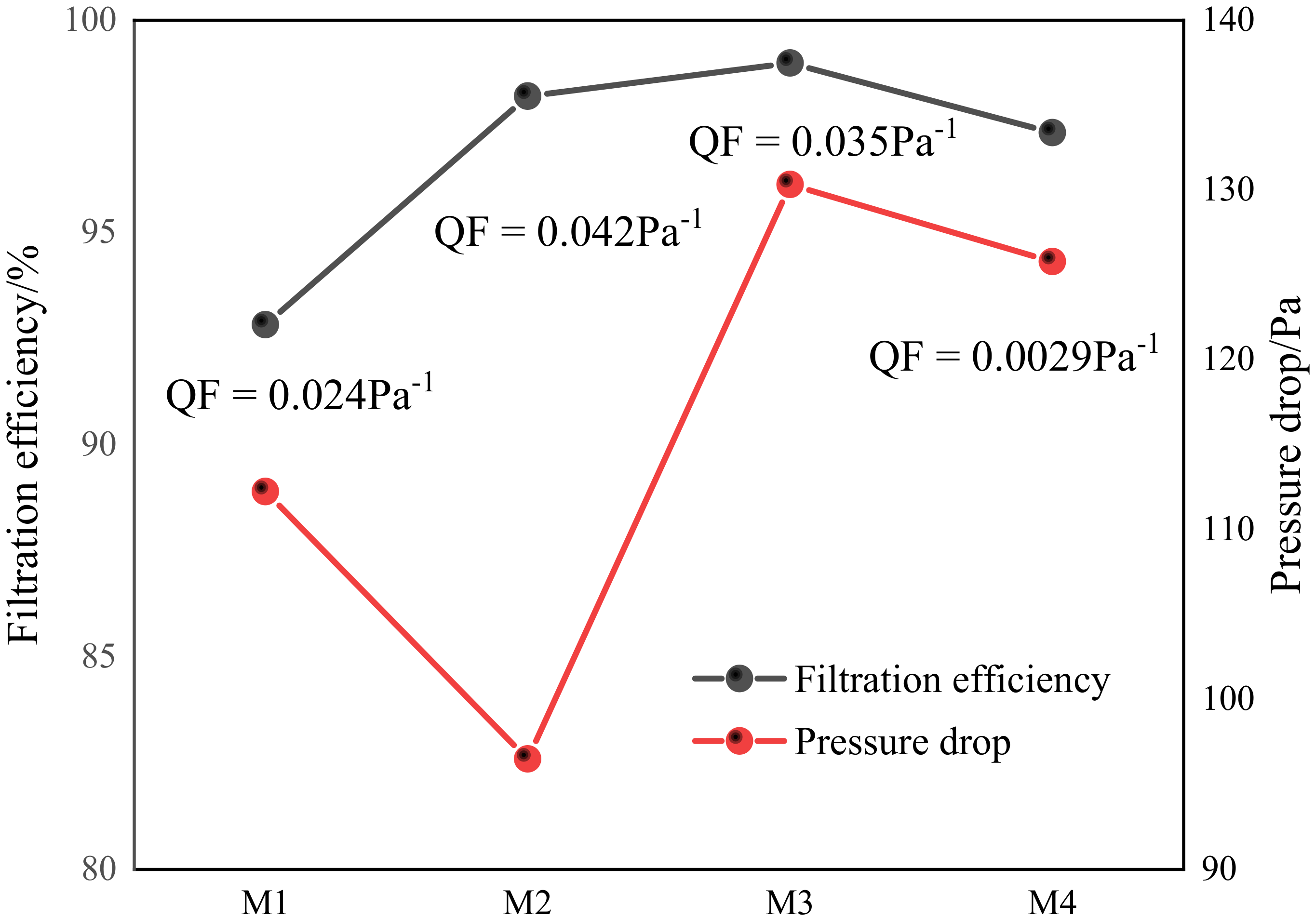Dual-Structure PVDF/SDS Nanofibrous Membranes for Highly Efficient Personal Protection in Mines
Abstract
:1. Introduction
2. Methods
2.1. Materials
2.2. Experimental Process
2.2.1. Preparation of Spinning Solution
2.2.2. Preparation of Nanofiber Membrane
2.3. Characterization
3. Results and Discussion
3.1. Morphological Analysis of Nanofiber Membranes
3.2. The Chemical Structure Properties of Nanofiber Membranes
3.3. The Analysis of Thermal Stability
3.4. The Filtration Performance of Nanofiber Membranes
4. Conclusions
Author Contributions
Funding
Institutional Review Board Statement
Informed Consent Statement
Data Availability Statement
Conflicts of Interest
References
- Shekarian, Y.; Rahimi, E.; Shekarian, N.; Rezaee, M.; Roghanchi, P. An analysis of contributing mining factors in coal workers’ pneumoconiosis prevalence in the United States coal mines, 1986–2018. Int. J. Coal Sci. Technol. 2021, 8, 1227–1237. [Google Scholar] [CrossRef]
- Liu, M.P.; Lin, M.Y.; Hu, S.P.; You, X.F.; Li, L. Effect of biomass surfactant on dehydration performance of low-rank coal ant its mechanism. J. Shandong Univ. Sci. Technol. (Nat. Sci.) 2021, 40, 28–37. [Google Scholar]
- Han, W.B.; Zhou, G.; Wang, J.P.; Jiang, W.J.; Zhang, Q.; Kong, Y.; Miao, Y.N. Experimental investigation on combined modifcation for micro physicochemical characteristics of coal by compound reagents and liquid nitrogen freeze-thaw cycle. Fuel 2021, 292, 120287. [Google Scholar] [CrossRef]
- Zhang, K.X.; Zhang, J.; Wei, J.P.; Ren, T.; Xu, X.Y. Coal seam water infusion for dust control: A technical review. Environ. Sci. Pollut. Res. 2019, 26, 4537–4554. [Google Scholar] [CrossRef]
- Zhang, Q.T.; Zhou, G.; Hu, Y.Y.; Xing, M.Y.; Zhang, R.; Wang, P.F.; Hu, S.Y. Microwetting dynamic behavior and mechanism for coal dust based on low feld NMR method—A case study. Fuel 2021, 297, 120702. [Google Scholar] [CrossRef]
- Li, S.L.; Zhou, G.; Liu, Z.Q.; Wang, N.G.; Wei, Z.Y.; Liu, W. Synthesis and performance characteristics of a new ecofriendly crust-dust suppressant extracted from waste paper for surface mines. J. Clean. Prod. 2020, 258, 120620. [Google Scholar] [CrossRef]
- Zhou, G.; Zhang, Q.T.; Hu, Y.Y.; Gao, D.H.; Wang, S.C.; Sun, B. Dust removal effect of negatively-pressured spraying collector for advancing support in fully mechanized coal mining face: Numerical simulation and engineering application. Tunn. Undergr. Space Technol. 2020, 95, 103149. [Google Scholar] [CrossRef]
- Ding, J.F.; Zhou, G.; Liu, D.; Jiang, W.J.; Wei, Z.Y.; Dong, X.S. Synthesis and performance of a novel high-efficiency coal dust suppressant based on self-healing gel. Environ. Sci. Technol. 2020, 54, 7992–8000. [Google Scholar] [CrossRef]
- Jiang, W.J.; Zhou, G.; Duan, J.J.; Liu, D.; Zhang, Q.T.; Tian, F.C. Synthesis and characterization of a multifunctional sustained release organic−inorganic hybrid microcapsule with self-healing and flame-retardancy properties. Appl. Mater. Interfaces 2021, 13, 15668–15679. [Google Scholar] [CrossRef]
- Liu, R.L.; Ji, X.D.; Zhou, G.; Liu, Z.Q.; Xu, Q.F.; Ramakrishna, S. Electrospun nanofibers for personal protection in mines. Chem. Eng. J. 2021, 404, 126558. [Google Scholar] [CrossRef]
- Sun, Q.Q.; Leung, W.W.F. Charged PVDF multi-layer filters with enhanced filtration performance for filtering nano-aerosols. Sep. Purif. Technol. 2019, 212, 854–876. [Google Scholar] [CrossRef]
- Song, Y.S.; Yun, Y.H.; Lee, D.Y.; Kim, B.Y. Effect of PVDF Concentration and Number of Fiber Lines on Piezoelectric Properties of Polymeric PVDF Biosensors. Fibers Polym. 2021, 22, 1200–1207. [Google Scholar] [CrossRef]
- Spasova, M.; Manolova, N.; Markova, N.; Rashkov, I. Superhydrophobic PVDF and PVDF-HFP nanofibrous mats with antibacterial and anti-biofouling properties. Appl. Surf. Sci. 2016, 363, 363–371. [Google Scholar] [CrossRef]
- Li, X.X.; Ji, D.X.; Yu, B.; Ghosh, R.; He, J.H.; Qin, X.H.; Ramakrishna, S. Boosting piezoelectric and triboelectric effects of PVDF nanofiber through carbon-coated piezoelectric nanoparticles for highly sensitive wearable sensors. Chem. Eng. J. 2021, 426, 130345. [Google Scholar] [CrossRef]
- Li, M.; Sun, J.X.; Chen, G.; Yao, S.Y.; Cong, B.W. Construction double electric field of sulphur vacancies as medium ZnS/Bi2S3-PVDF self-supported recoverable piezoelectric film photocatalyst for enhanced photocatalytic performance. Appl. Catal. B Environ. 2022, 301, 120792. [Google Scholar] [CrossRef]
- van Goethem, C.; de Beeck, D.O.; Ilyas, A.; Thijs, M.; Koeckelberghs, G.; Aerts, P.E.M.; Vankelecom, I.F.J. Ultra-thin and highly porous PVDF-filters prepared via phase inversion for potential medical (COVID-19) and industrial use. J. Membr. Sci. 2021, 639, 119710. [Google Scholar] [CrossRef]
- Xiong, J.P.; Shao, W.L.; Wang, L.; Cui, C.; Gao, Y.F.; Jin, Y.R.; Yu, H.Q.; Han, P.J.; He, J.X. High-performance anti-haze window screen based on multiscale structured polyvinylidene fluoride nanofibers. J. Colloid Interface Sci. 2022, 607, 711–719. [Google Scholar] [CrossRef]
- Shen, X.L.; Deng, Z.J.N.P.; Fan, J.; Wang, L.; Xia, Z.P.; Liu, Y.; Liu, J. Rational designing of tree-like polymer gel membrane based on PVDF/lamellar organic montmorillonite nanofiber with excellent flame retardancy and superior ion conductivity for high-performance lithium-ion capacitor. Chem. Eng. J. 2021, 422, 130116. [Google Scholar] [CrossRef]
- Li, Z.J.; Kang, W.M.; Zhao, H.H.; Hu, M.; Ju, J.G.; Denga, N.P.; Cheng, B.W. Fabrication of a polyvinylidene fluoride tree-like nanofiber web for ultra high performance air filtration. Rsc Adv. 2016, 6, 91243–91249. [Google Scholar] [CrossRef]
- Li, X.; Wang, C.; Huang, X.H.; Zhang, T.H.; Wang, X.F.; Min, M.H.; Wang, L.M.; Huang, H.L.; Hsiao, B.S. Anionic Surfactant-Triggered Steiner Geometrical Poly(vinylidene fluoride) Nanofiber/Nanonet Air Filter for Efficient Particulate Matter Removal. ACS Appl. Mater. Interfaces 2018, 10, 42891–42904. [Google Scholar] [CrossRef]
- Liu, G.; Nie, J.; Han, C.; Jiang, T.; Yang, Z.; Pang, Y.; Xu, L.; Guo, T.; Bu, T.; Zhang, C.; et al. Self-Powered Electrostatic Adsorption Face Mask Based on a Triboelectric Nanogenerator. ACS Appl. Mater. Interfaces 2018, 10, 7126–7133. [Google Scholar] [CrossRef] [PubMed]
- Mei, Y.; Wang, Z.M.; Li, X.S. Improving Filtration Performance of Electrospun Nanofiber Mats by a Bimodal Method. J. Aoolied Polym. Sci. 2013, 128, 1089–1094. [Google Scholar] [CrossRef]
- Li, Z.J.; Xu, Y.Z.; Fan, L.L.; Kang, W.M.; Cheng, B.W. Fabrication of polyvinylidene fluoride tree-like nanofiber via one-step electrospinning. Mater. Des. 2016, 92, 95–101. [Google Scholar] [CrossRef]
- Zhao, X.L.; Li, Y.Y.; Hua, T.; Jiang, P.; Yin, X.; Yu, J.Y.; Ding, B. Low-resistance dual-purpose air filter releasing negative ions and effectively capturing PM2.5. ACS Appl. Mater. Interfaces 2017, 9, 12054. [Google Scholar] [CrossRef] [PubMed]
- Fu, Q.F.; Fang, J.; Shi, J.; Cao, X.Q.; Lv, X.J. Effect of particulate matter on dust removal performance of polyacrylonitrile fiber bundle filter. J. Shandong Univ. Sci. Technol. (Nat. Sci.) 2019, 38, 33–39. [Google Scholar]
- Liu, R.L.; Zhou, G.; Wang, C.M.; Jiang, W.J.; Wei, X. Preparation and performance characteristics of an environmentally-friendly agglomerant to improve the dry dust removal effect for filter material. J. Hazard. Mater. 2020, 397, 122734. [Google Scholar] [CrossRef] [PubMed]











Publisher’s Note: MDPI stays neutral with regard to jurisdictional claims in published maps and institutional affiliations. |
© 2022 by the authors. Licensee MDPI, Basel, Switzerland. This article is an open access article distributed under the terms and conditions of the Creative Commons Attribution (CC BY) license (https://creativecommons.org/licenses/by/4.0/).
Share and Cite
Zhou, G.; Liu, R.; Xu, Q.; Wang, K.; Wang, Y.; Ramakrishna, S. Dual-Structure PVDF/SDS Nanofibrous Membranes for Highly Efficient Personal Protection in Mines. Membranes 2022, 12, 482. https://doi.org/10.3390/membranes12050482
Zhou G, Liu R, Xu Q, Wang K, Wang Y, Ramakrishna S. Dual-Structure PVDF/SDS Nanofibrous Membranes for Highly Efficient Personal Protection in Mines. Membranes. 2022; 12(5):482. https://doi.org/10.3390/membranes12050482
Chicago/Turabian StyleZhou, Gang, Rulin Liu, Qingfeng Xu, Kaili Wang, Yongmei Wang, and Seeram Ramakrishna. 2022. "Dual-Structure PVDF/SDS Nanofibrous Membranes for Highly Efficient Personal Protection in Mines" Membranes 12, no. 5: 482. https://doi.org/10.3390/membranes12050482
APA StyleZhou, G., Liu, R., Xu, Q., Wang, K., Wang, Y., & Ramakrishna, S. (2022). Dual-Structure PVDF/SDS Nanofibrous Membranes for Highly Efficient Personal Protection in Mines. Membranes, 12(5), 482. https://doi.org/10.3390/membranes12050482







